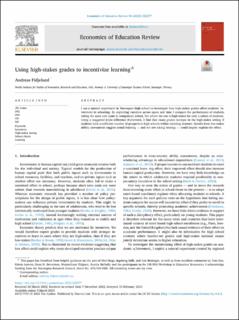| dc.contributor.author | Fidjeland, Andreas | |
| dc.date.accessioned | 2023-04-17T11:42:09Z | |
| dc.date.available | 2023-04-17T11:42:09Z | |
| dc.date.created | 2023-03-17T14:25:23Z | |
| dc.date.issued | 2023 | |
| dc.identifier.citation | Economics of Education Review. 2023, 94 . | |
| dc.identifier.issn | 0272-7757 | |
| dc.identifier.uri | https://hdl.handle.net/11250/3063332 | |
| dc.description.abstract | I use a natural experiment in Norwegian high school to investigate how high-stakes grades affect students’ investment in schooling. By exploiting variation across space and time I compare the performance of students taking the same exit exam in compulsory school, but where the test is high-stakes for only a subset of students. Using a staggered triple-difference framework, I find that exam grades increase in the high-stakes setting if students have a sufficient number of prospective high schools within traveling distance. Results from low-stakes ability assessments suggest actual learning — and not test-taking strategy — could largely explain the effect. | |
| dc.language.iso | eng | |
| dc.title | Using high-stakes grades to incentivize learning | |
| dc.title.alternative | Using high-stakes grades to incentivize learning | |
| dc.type | Peer reviewed | |
| dc.type | Journal article | |
| dc.description.version | publishedVersion | |
| dc.source.pagenumber | 0 | |
| dc.source.volume | 94 | |
| dc.source.journal | Economics of Education Review | |
| dc.identifier.doi | 10.1016/j.econedurev.2023.102377 | |
| dc.identifier.cristin | 2134855 | |
| cristin.ispublished | true | |
| cristin.fulltext | original | |
| cristin.qualitycode | 2 | |
